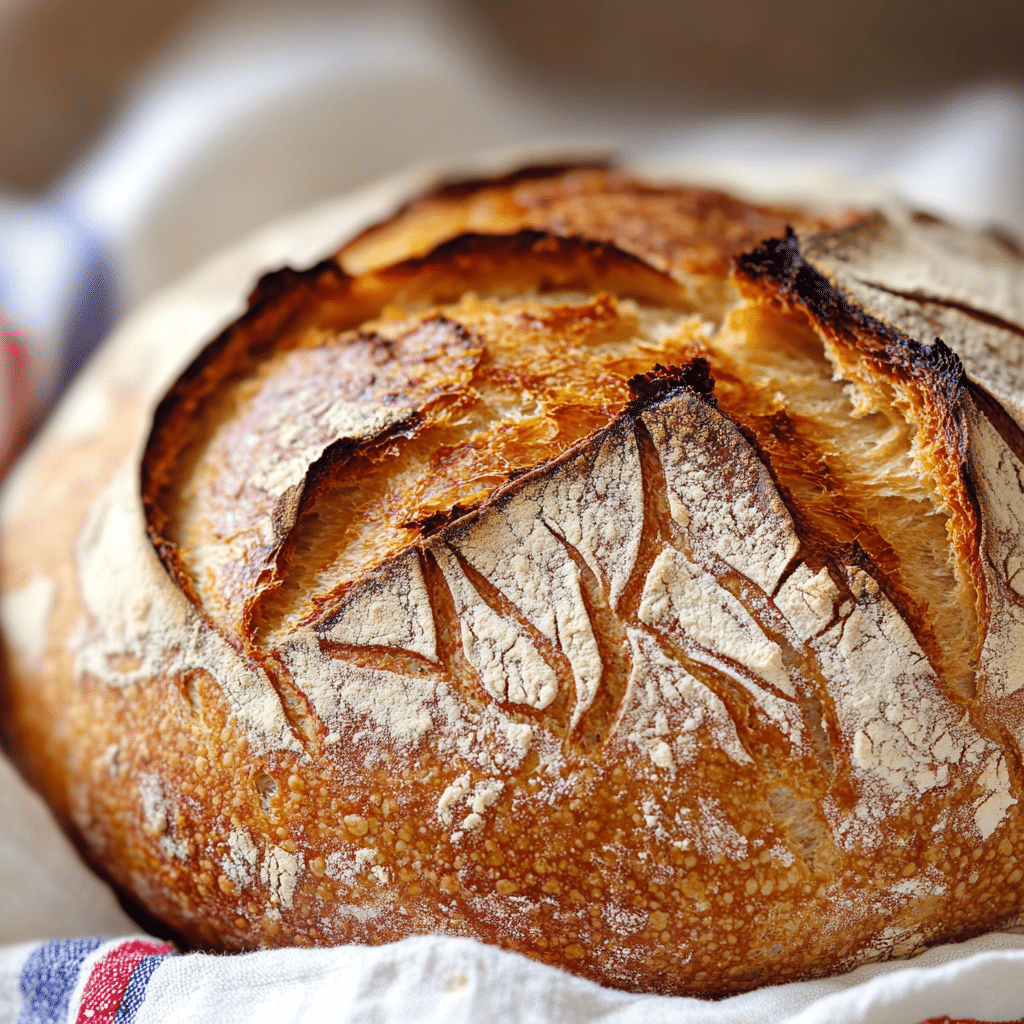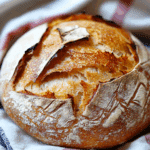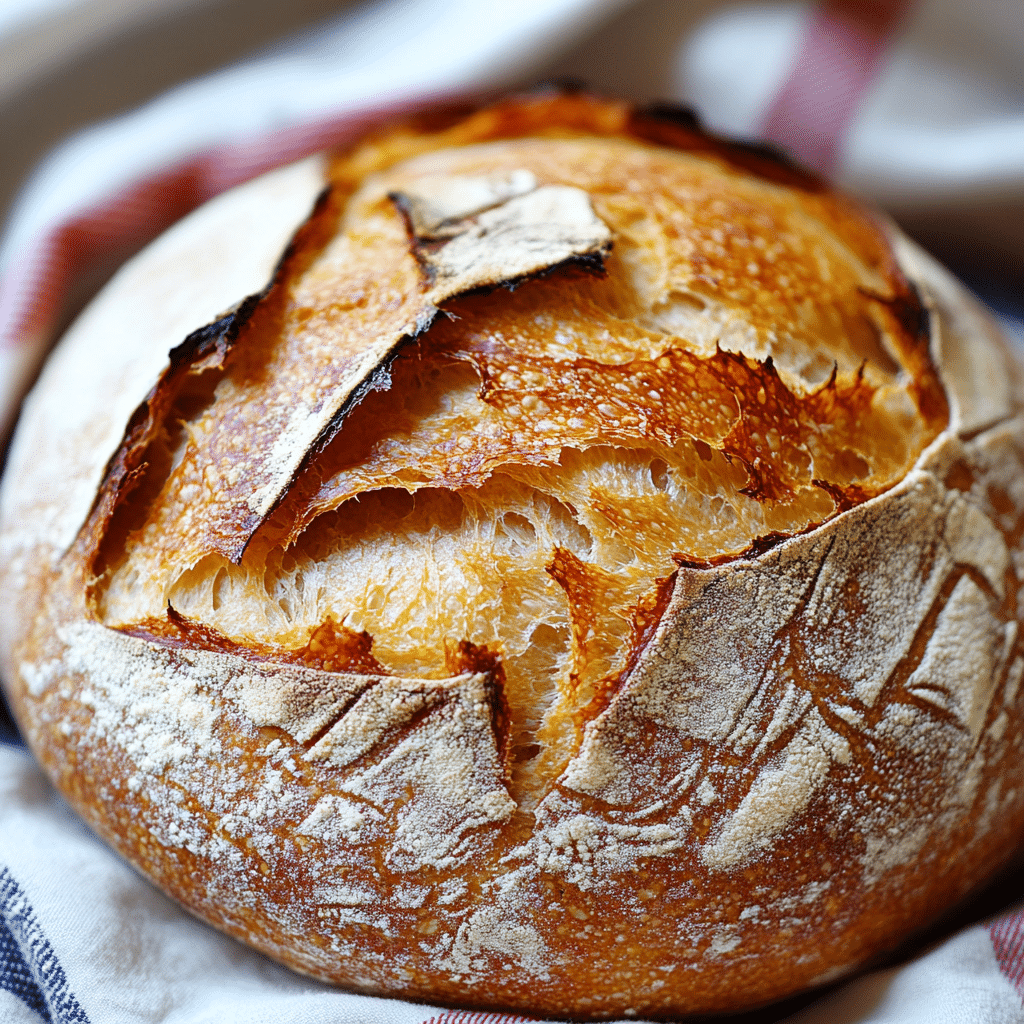Why You’ll Love This Recipe
This Beginner’s Sourdough Bread Recipe is perfect for anyone starting their journey into sourdough baking. With a crusty exterior, airy interior, and tangy flavor, it’s both rustic and rewarding. Requiring only basic ingredients and no commercial yeast, this recipe teaches you the fundamentals of fermentation and dough handling while producing a beautiful artisan loaf.
ingredients
(Tip: You’ll find the full list of ingredients and measurements in the recipe card below.)
sourdough starter (active and bubbly)all-purpose or bread flourwater (preferably filtered)salt
directions
In a large bowl, mix the sourdough starter and water until dissolved.
Add the flour and stir until a shaggy dough forms.
Cover with a damp towel and let rest for 30 minutes (autolyse phase).
Add salt and knead it into the dough with wet hands until fully incorporated.
Cover and let the dough rise at room temperature for 4-6 hours, performing stretch-and-folds every 30-45 minutes during the first 2-3 hours.
After the bulk fermentation, turn the dough onto a floured surface and shape it into a round or oval loaf.
Place the shaped dough into a floured proofing basket or bowl lined with a floured towel.
Cover and refrigerate overnight (8–12 hours) for cold fermentation.
Preheat your oven to 475°F (245°C) with a Dutch oven inside.
Carefully transfer the dough to parchment paper, score the top with a sharp blade, and place it into the hot Dutch oven.
Cover and bake for 20 minutes, then remove the lid and bake for another 20–25 minutes until golden brown.
Cool completely on a wire rack before slicing.
Servings and timing
This recipe yields 1 loaf (approximately 8–10 slices).
Preparation time: 30 minutes
Bulk fermentation: 4–6 hours
Cold fermentation: 8–12 hours
Baking time: 45 minutes
Total time: 13–19 hours including resting and fermentation
Variations
Add seeds (like sesame, flax, or sunflower) to the dough for texture and flavor.
Incorporate herbs like rosemary or thyme for a savory twist.
Use a mix of whole wheat and white flour for a heartier loaf.
Swap some water for milk or buttermilk for a softer crumb.
Mix in dried fruits and nuts for a sweet sourdough variation.
storage/reheating
Store the cooled bread in a paper bag or wrapped in a clean kitchen towel for up to 2 days at room temperature.
For longer storage, slice and freeze the loaf in a zip-top bag for up to 2 months.
To reheat, toast slices directly from frozen or warm whole loaves in a 350°F (175°C) oven for 10–15 minutes.

FAQs
Do I need a Dutch oven?
While a Dutch oven gives the best crust, you can bake on a baking stone or sheet with a tray of water for steam.
How do I know when my sourdough starter is ready?
It should be bubbly, doubled in size, and pass the float test (a spoonful floats in water).
Can I skip the overnight fermentation?
It’s not recommended. Cold proofing develops better flavor and structure.
Why is my dough so sticky?
Sourdough dough is naturally wetter. Use wet hands for handling and avoid adding too much flour.
How do I score the dough?
Use a sharp razor blade or bread lame. Shallow slashes guide how the bread expands in the oven.
What flour is best?
Bread flour yields a chewier texture, while all-purpose flour gives a softer crumb. You can use a blend.
Can I use whole wheat flour?
Yes, but you may need more water, and the bread may be denser.
Why didn’t my bread rise?
This could be due to an inactive starter, under-proofing, or cold dough at baking time.
Do I have to knead the dough?
No traditional kneading is required—stretch-and-folds during bulk fermentation help build structure.
Can I make mini loaves?
Yes, divide the dough before final shaping and adjust baking times accordingly.
Conclusion
This Beginner’s Sourdough Bread Recipe is an approachable gateway into the world of natural fermentation. With patience and a little practice, you’ll be rewarded with a gorgeous loaf boasting rich flavor and satisfying texture. Master this simple method and you’ll have a timeless skill that turns basic ingredients into something extraordinary.
Print
Beginner’s Sourdough Bread Recipe
- Prep Time: 12 hours
- Cook Time: 45 minutes
- Total Time: 12 hours 45 minutes
- Yield: 1 loaf
- Category: Bread
- Method: Baking
- Cuisine: American
- Diet: Vegetarian
Description
A simple and beginner-friendly sourdough bread recipe that yields a deliciously crusty loaf with a soft, chewy interior using just a few ingredients and natural fermentation.
Ingredients
- 500g bread flour
- 375g water (75% hydration)
- 100g active sourdough starter
- 10g salt
Instructions
- In a large bowl, mix the flour and water until just combined. Cover and let it rest for 30 minutes (autolyse).
- Add the sourdough starter and salt to the dough. Mix until fully incorporated.
- Let the dough rest for 30 minutes, then begin stretch and folds every 30 minutes for the next 2 hours (4 sets total).
- Cover and let the dough bulk ferment at room temperature for 4-6 hours until it has roughly doubled in size.
- Turn the dough onto a lightly floured surface and shape into a round loaf. Let it rest for 20 minutes.
- Final shape the dough and place into a floured proofing basket or bowl. Cover and refrigerate overnight (8-12 hours).
- Preheat your oven to 475°F (245°C) with a Dutch oven inside for at least 30 minutes.
- Score the dough and transfer it into the hot Dutch oven. Cover and bake for 20 minutes, then uncover and bake for another 20-25 minutes until golden brown.
- Let the bread cool completely on a wire rack before slicing.
Notes
- Ensure your sourdough starter is active and bubbly before using.
- You can adjust hydration slightly if the dough is too sticky or dry.
- Baking times may vary depending on your oven.
